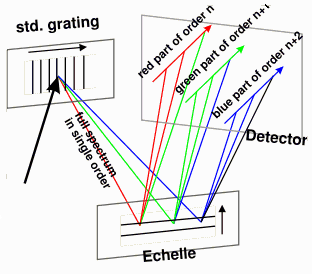.
Échelle grating

Échelle Spectrometer: The first standard grating is optimized for a single lower order, while multiple higher orders of the échelle have an optimized output intensity. Both diffractive elements are mounted orthogonally in such a way that the highly illuminated orders of the échelle are transversally separated. Since only parts of the full spectrum of each individual order lie in the illuminated region, only portions of the different orders overlap spectrally (i.e. green line in red portion). (*)
An Échelle grating ('échelle'= french for stairs/ladder) is a type of diffraction grating which is characterised by a relatively low grooves density but is optimised for high diffraction orders. Échelle gratings are, like other types of diffraction grating, used in spectrometers and similar instruments, such as HARPS, and numerous other astronomical instruments.
Principle
As with other diffraction gratings, the échelle grating essentially consists of a number of slits with widths close to the wavelength of the diffracted light. Therefore light of a single wavelength in a standard grating at normal incidence is diffracted to the central zero order and successive higher orders at specific angles, defined by the grating density/wavelength ratio and the selected order. The angular spacing between higher orders monotonically decreases and higher orders can get very close to each other, while lower ones are well separated. The intensity of the diffraction pattern can be altered by tilting the grating. Especially with reflective gratings (where the holes are replaced by a highly reflective surface), the reflective portion can be tilted (blazed) to scatter a majority of the light into the preferred direction of interest (specific diffraction order). For multiple wavelengths the same is true; however, there it is possible that longer wavelengths of a higher order might overlap with the next order(s) of a shorter wavelength, which usually is an unwanted side effect.
In échelle gratings, however, this behaviour is deliberately used and the blaze is optimized for multiple overlapping higher orders. Since this overlap is not directly useful, a second, perpendicularly mounted dispersive element (grating or prism) is inserted as an "order separator" into the beam path. Hence the spectrum consists of stripes with different, but slightly overlapping, wavelength ranges that run across the imaging plane in an oblique pattern. Exactly this behaviour helps to overcome imaging problems with broadband, high-resolution spectroscopic devices, like utilisation of extremely long, linear detection arrays or strong defocus or other aberrations and makes the use of readily available 2D-detection arrays feasible, which reduces measurement times and improves efficiency.
References
* High Resolution Échelle Spectrometer (Hawaii) [1]
* R.J. Krupa, E.R. Pereira, Ruling of an échelle grating, in: American Laboratory News, Jan 1999 Production of Échelles
* Spectroscopy on Small Telescopes: The Échelle Spectrograph, by Martin J. Porter Échelle Spectrograph Design Concepts
Retrieved from "http://en.wikipedia.org/"
All text is available under the terms of the GNU Free Documentation License

